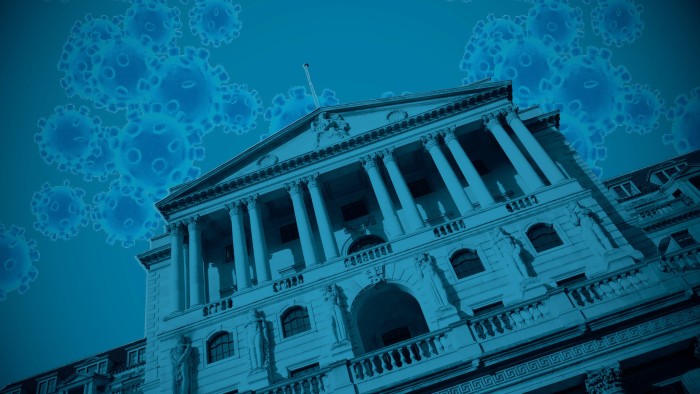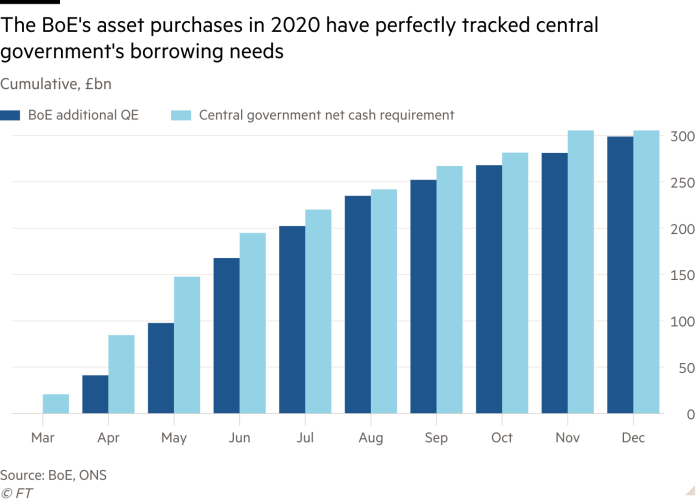Investors sceptical over Bank of England’s QE programme

Roula Khalaf, Editor of the FT, selects her favourite stories in this weekly newsletter.
The Bank of England is on course for a difficult 2021, after a Financial Times survey found investors believe the central bank’s quantitative easing programme is a thinly veiled attempt to finance the government’s deficit to keep its borrowing costs down.
The BoE maintains that its QE programme is calibrated to keep inflation close to its 2 per cent target. Andrew Bailey, the central bank’s governor, said in November: “We do not . . . set a level of quantitative easing and asset purchases in any way related to what the government is going to borrow.”
But investors are convinced the BoE bought an additional £450bn of gilts during the Covid-19 crisis in order to ease the government’s huge programme of borrowing by keeping debt servicing costs at rock bottom.
An FT survey of the 18 biggest players in the market for UK government bonds found the overwhelming majority believe that QE in its current incarnation works by buying enough bonds to mop up the amount the government issues and keep interest rates low.
In particular, most said they thought the scale of BoE bond buying in the current crisis had been calibrated to absorb the flood of extra bonds sold this year, suggesting they believe the central bank is financing the government’s borrowing.
“In this extraordinary year of gilt supply, the BoE has been the dominant buyer,” said Matthew Amis, of Aberdeen Standard Investments. “Without this significant support, bond yields would have risen significantly. Very simply, the gilt market could not have taken down the record £485bn supplied by the Debt Management Office to the market this year.”
Responses to the FT survey suggest that investors place fiscal financing at the centre of their understanding of how QE works, a conviction that has strengthened in the current crisis compared with previous rounds of bond buying. This contrasts with the BoE’s view that it is signalling its intent to keep inflation on target.
“Signalling impacts are more limited now than in the early days of QE,” said Simon Bell, fixed income fund manager at Legal & General Investment Management. “With each subsequent QE announcement, the impact has been lower. At the current juncture, the intention of the bank appears primarily to offset the Treasury supply to maintain the low level of yields.”

The divergent opinions on the purpose of the QE programme raise two risks for the UK economy in 2021. With financial markets convinced the BoE is financing the government’s deficit, if the central bank disappoints them with the amount of government bonds it is willing to buy, there is a danger that borrowing costs could rise sharply; but if the bank ramps up bond buying to appease financial markets, it risks allowing inflation to get out of control.
These risks were recognised in a speech by Andy Haldane, the central bank’s chief economist, in November, when he said that any divergence of views on QE put the central bank in “deep and uncharted waters”.
With bond yields already at record lows, few investors believe the purpose of QE is to lower them further. Instead, the effect is to keep yields roughly where they are while the government’s Debt Management Office ramps up its issuance of gilts, effectively passing the baton for stimulating the economy to the Treasury.
“Fiscal-monetary co-ordination has been a noteworthy feature of the UK’s Covid-19 policy response, with November’s QE expansion being announced in tandem with the chancellor’s decision to extend the furlough scheme until March 2021,” said Gurpreet Gill, macro strategist in the fixed income team at Goldman Sachs Asset Management. “BoE buying has largely kept pace with Treasury issuance in recent months, keeping gilt yields in check.”
Jim Leaviss, chief investment officer for public fixed income at M&G Investments, said that since the pandemic began the “physical act” of QE has been the most important feature in 2020, in contrast to earlier periods of easing, when the “signalling” effect of the central bank’s intentions was more powerful.
Investors are also sceptical about whether the BoE’s asset purchases have much impact on inflation or inflation expectations — which is a worry given that hitting its 2 per cent inflation target is the BoE’s central mandate.
“The problem now is that growth or inflation has never particularly materialised [as a result of the BoE’s bond purchases],” said Craig Inches, head of rates and cash at Royal London Asset Management. “As a result all QE has achieved is asset price growth.”
Lars Salmon, head of fixed income trading for Europe at Fidelity International, said: “While the idea of raising inflation expectations, to help reach the bank’s target of actual inflation, is very popular, it is arguably less clear to what extent central banks can really influence inflation expectations and actual inflation.”
Investors’ understanding of how QE works is uncomfortable for the BoE, which does not want to be seen as financing extraordinarily large government borrowing. But if investors believe this is what the central bank is doing, the possibility of monetary policy errors expands rapidly, according to Mr Haldane.
He warned that if market expectations were driven by the government’s borrowing needs, failure to meet those expectations could cause an unhelpful rise in borrowing costs, while continuing to meet them “puts monetary policy on a potentially undesirable course over in the medium term”.
Comments